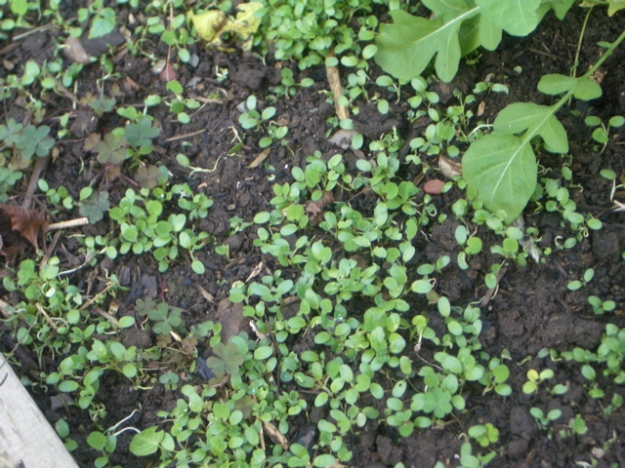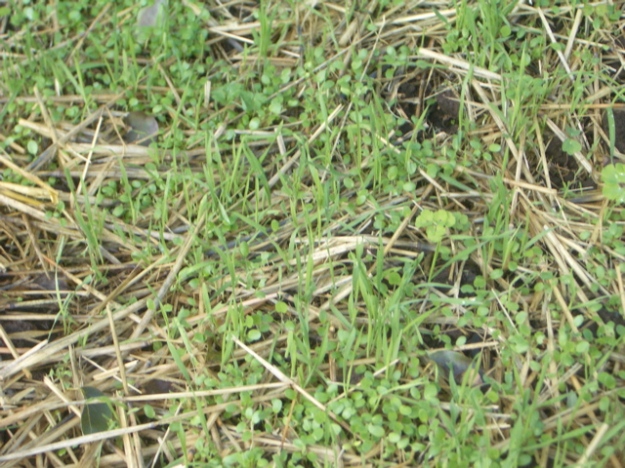Here are some cover crop experiments. Not sure if I will garden in this garden next year, or if someone else will have the pleasure of my raised beds. But, in the spirit of diversity and permaculture I have tossed a few things out there, and here are the results so far (as of late October).
One of my favorites is crimson clover, if I can get it in early enough to germinate. This I threw under the tomato plants that I am still gleaning a few tomatoes from, in addition to some compost from the compost bins. Clover is gorgeous, a good nectar plant for the bees if I let it go to bloom, and pretty easy to till under in the spring. It will look puny and weak until February, when it will start to take off and fill the beds. It does fine in our winters without any protection as long as it germinates in time.
This is a ‘clear out the old cover crop seed and hedge your bets’ mix. The rye is a great fall cover crop, especially if you prepped your beds too late to sow crimson clover, as rye will germinate at lower temperatures. The two are mutually beneficial, the clover providing nitrogen fixing bacteria in the soil that the rye can use, and also some support to the rye as it gets tall. The rye gives the clover some physical protection, and seems to deter slugs somewhat (anecdotal evidence). Rye is tougher to till under and breaks down more slowly in my experience, and of course the clover fixes more nitrogen. Again, if I let it go, I can harvest the rye for bread flour and the bees can use the clover. I can feed all of it to the rabbits and chickens either fresh or dried.
Another experiment: I threw out some organic hard red wheat berries that I got from the bulk bins for bread making with clover just to see what would happen. I have read that store bought wheat has often been heat treated and won’t germinate, but that was not my experience here! Same idea as the rye/clover mix.
The other cover crop I tossed out this fall was a mix of vetch, austrian pea, clover, oats and rye. It hadn’t germinated by the time I took these photos (but it has now). I can eat the austrian pea shoots in the spring for early greens, if I so choose. And I have never used vetch, so that will be something new. In the summer I have undersown with buckwheat and flax, both attractive to pollinators. The flax has a lovely blue flower. Again, organic ‘seed’ that I bought in the bulk section of the grocery store with good results.
I also have a patch of alfalfa going in the garden (do Not tell my husband this) as an experiment. As someone who wants to raise organic meat I am very interested in forage plants (especially perennials) that are easy to grow and use as feed. I have just ‘mowed’ my patch by hand and fed directly to the rabbits and chickens. In return it will get some rabbit/chicken compost. The alfalfa was a slow starter, needs irrigation (why it is in the raised beds with the vegetables) and plenty of lime. It seems well established now, so I am curious to see how it does next season.
This late in the year you can still get a cover crop in. Rye will germinate at the first opportunity either now or in the spring, and Fava beans ( I would go with the big seeded ones if you want to eat some of your cover crop next year) can be planted any time the ground can be worked. If you want a nitrogen fixer too, you can toss out some crimson clover in the spring once things start to warm up. Under cloche even earlier.
The final fall experiment is thanks to a suggestion from Steve Solomon’s Gardening Without Irrigation (which you can read free online here). Let your summer planted kales grow as tall as you can all summer, then prune off all the leaves and the growing tip, and the plant will produce new branchlets of tender baby kale. You get more leaves, and better quality. And in the spring, raab-omania. Here is my red russian kale producing new branchlets (I probably should trim those stems back a little further).
We shall see if this plant survives the winter after such abuse. I have tried this before with collards with pretty good results, but not this late in the season.



